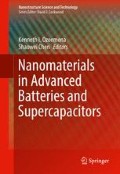Abstract
Multivalent battery systems like rechargeable magnesium (Mg) batteries are garnering more interest as candidate post-lithium (Li) battery systems, for eventual applications in electric vehicles (EVs) and plug-in hybrid vehicles (PHVs). Mg, being divalent and denser, is theoretically capable of delivering a higher volumetric energy density (3833 mAh cm−3) than Li (2061 mAh cm−3), making it a viable battery system for addressing current range and space concerns in vehicles. To date, various low-voltage electrolytes have been utilized in Mg battery systems, due to the incompatibility of high-voltage conventional battery electrolytes (TFSI−, ClO4 −, PF6 −) with Mg metal anodes. It is however possible to use conventional battery electrolytes for Mg battery systems, by changing the type of anode, from a Mg metal anode to a Mg-ion insertion-type anode (e.g., Bi and Sn), as recently reported. This fact has produced two primary avenues of research for anodes in Mg batteries: the first being to utilize insertion-type anodes via their engineering as effective nanomaterials and the second focused on fundamental studies of the anode/electrolyte interface.
Here, we report the recent progress in electrochemical transport properties and in situ/operando X-ray absorption measurements for Mg deposition and the use of insertion-type anodes for rechargeable Mg-ion batteries. Results from such recent fundamental analyses, focused on studying and understanding these various insertion-type anodes and anode/electrolyte interfaces, are presented and discussed. Further, the authors’ perspective on both research avenues (i.e., insertion-type anodes and nanomaterials, as well as fundamental studies and anode/electrolyte interfaces) for anodes in Mg batteries is presented, via critically examining the importance of both avenues toward the overall advancement of Mg batteries.
Access this chapter
Tax calculation will be finalised at checkout
Purchases are for personal use only
References
Mizuno F, Singh N, Arthur TS, Fanson PT, Ramanathan M, Benmayza A, Prakash J, Liu Y-S, Glans P-A, Guo J (2014) Understanding and overcoming the challenges posed by electrode/electrolyte interfaces in rechargeable magnesium batteries. Front Energy Res 2:1–11
Singh N, Arthur TS, Ling C, Matsui M, Mizuno F (2013) A high energy-density tin anode for rechargeable magnesium-ion batteries. Chem Commun 49:149–151
Muldoon J, Bucur CB, Gregory T (2014) Quest for nonaqueous multivalent secondary batteries: magnesium and beyond. Chem Rev 114:11683–11720
Bruce PG, Freunberger SA, Hardwich LJ, Tarascon J-M (2012) Li–O2 and Li-S batteries with high energy storage. Nat Mater 11:19–29
Arthur TS, Singh N, Matsui M (2012) Electrodeposited Bi, Sb and Bi1–X SbX alloys as anodes for Mg-ion batteries. Electrochem Commun 16:103–106
Yoo HD, Shterenberg I, Gofer Y, Gershinsky G, Pour N, Aurbach D (2013) Mg rechargeable batteries: an on-going challenge. Energy Environ Sci 6:2265–2279
Saha P, Datta MK, Velikokhatnyi OI, Manivannan A, Almon D, Kumta PN (2014) Rechargeable magnesium battery: current status and key challenges for the future. Prog Mater Sci 66:1–86
Tran TT, Lamanna WM, Obrovac MN (2012) Evaluation of Mg {N(SO2CF3)2}2/acetonitrile electrolyte for use in Mg-ion cells. J Electrochem Soc 159:A2005–A2009
Orikasa Y, Masese T, Koyama Y, Mori T, Hattori M, Yamamoto K, Okado T, Huang Z-D, Minato T, Tassel C, Kim J, Kobayashi Y, Abe T, Kageyama H, Uchimoto Y (2014) High energy density rechargeable magnesium battery using earth-abundant and non-toxic elements. Sci Rep 4:5622. doi:10.1038/srep05622
Ha S-Y, Lee Y-W, Woo SW, Koo B, Kim J-S, Cho J, Lee KT, Choi N-S (2014) Magnesium (II) bis(trifluoromethane sulfonyl) imide-based electrolytes with wide electrochemical windows for rechargeable magnesium batteries. ACS Appl Mater Interfaces 6:4063–4073
Mohtadi R, Matsui M, Arthur TS, Hwang S-J (2012) Magnesium borohydride: from hydrogen storage to magnesium battery. Angew Chem Int Ed 51:1–5
Aurbach D, Cohen Y, Moshkovich M (2001) The study of reversible magnesium deposition by in situ scanning tunneling microscopy. Electrochem Solid-State Lett 4:A113–A116
Lu Z, Schechter A, Moshkovich M, Aurbach D (1999) On the electrochemical behavior of magnesium electrodes in polar aprotic electrolyte solutions. J Electroanal Chem 466:203–217
Barile C, Spatney R, Zavadil K, Gerwith A (2014) Investigating the reversibility of in situ generated magnesium organohaloaluminates for magnesium deposition and dissolution. J Phys Chem C 118:10694–10699
Aurbach D, Turgeman R, Chusid O, Gofer Y (2001) Spectroelectrochemical studies of magnesium deposition by in situ FTIR spectroscopy. Electrochem Commun 3:252–261
Nakayama Y, Kudo Y, Oki H, Yamamoto K, Kitajima Y, Noda K (2008) Complex structures and electrochemical properties of magnesium electrolytes. J Electrochem Soc 155:A754–A759
Arthur T, Glans P-A, Matsui M, Zhang R, Ma B, Guo J (2012) Mg deposition observed by in situ electrochemical Mg K-edge X-ray absorption spectroscopy. Electrochem Commun 24:43–46
Benmayza A, Ramanathan M, Arthur T, Matsui M, Mizuno F, Guo J, Glans P-A, Prakash J (2013) Effect of electrolytic properties of a magnesium organohaloaluminate electrolyte on magnesium deposition. J Phys Chem C 117:26881–26888
Shao Y, Gu M, Li X, Nie Z, Zuo P, Li G, Liu T, Xiao J, Cheng Y, Wang C, Zhang J-G, Liu J (2014) Highly reversible Mg insertion in nanostructured Bi for Mg ion batteries. Nano Lett 14:255–260
Author information
Authors and Affiliations
Corresponding authors
Editor information
Editors and Affiliations
Rights and permissions
Copyright information
© 2016 Springer International Publishing Switzerland
About this chapter
Cite this chapter
Arthur, T.S., Singh, N. (2016). Anodes and Anode/Electrolyte Interfaces for Rechargeable Magnesium Batteries. In: Ozoemena, K., Chen, S. (eds) Nanomaterials in Advanced Batteries and Supercapacitors. Nanostructure Science and Technology. Springer, Cham. https://doi.org/10.1007/978-3-319-26082-2_6
Download citation
DOI: https://doi.org/10.1007/978-3-319-26082-2_6
Published:
Publisher Name: Springer, Cham
Print ISBN: 978-3-319-26080-8
Online ISBN: 978-3-319-26082-2
eBook Packages: EnergyEnergy (R0)

